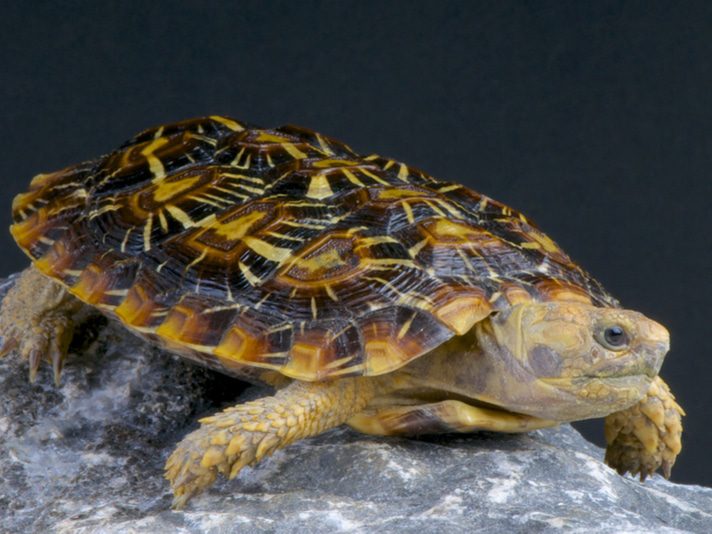Pancake tortoises are unlike any other tortoise in the world.
(Malacochersus tornieri)
Size
Adult shell length ranges from 6 to 7 inches long and about 1 inch tall
Life Span
At least 35 years and most likely much longer
Range
Southern Kenya and northern and western Tanzania
Natural Habitat
Rocky hills and slopes with rocky outcrops in arid savanna and scrub areas at altitudes from 100 to 6,000 feet
Captive Housing
Pancake tortoises can be housed indoors or outdoors. An indoor enclosure can be a 40-gallon terrarium or larger. Substrates of bark, coconut bedding or rabbit pellets are OK. Potting soil can also be used, but make sure it doesn’t contain fertilizer, pesticides or manure. Include a shallow water bowl large enough for the tortoise to soak.
Also provide hiding and climbing areas. I recommend the realistic artificial-rock hides on the market today. Give the tortoise two hiding spots: one on the cool side of the tank and one on the warm side. Flat rocks can also be stacked carefully in a corner of the enclosure to provide crevices for them to explore.
A fluorescent UVB bulb spanning the length of the enclosure takes care of the lighting needs. Provide a photoperiod of 12 hours of daylight.
For heating, a ceramic heat emitter of the appropriate wattage can provide a hotspot of 100 degrees Fahrenheit. The cooler side of the enclosure can range from 70 to 75 degrees. This temperature gradient allows the tortoise to choose its preferred body temperature. Keep the heat emitter on 24 hours a day.
Housing pancake tortoises outdoors is fine as long as you follow some enclosure-design precautions. Enclosure size needs to be at least 4 square feet for up to two tortoises. Add 2 square feet for every additional tortoise. Walls should be at least 1 foot tall, but taller is better for full-grown adults. The goal is to make sure they can’t reach the top when standing against the wall on their hind legs. I also recommend a screen top that covers the entire enclosure, because pancake tortoises are master climbers that can scale vertical walls when the mood hits them. A top ensures that your tortoise can’t leave. Set up cage furniture like you would for an indoor enclosure, but keep all rocks and other scalable items away from the enclosure walls.
Pancake tortoises can be housed outdoors in the spring, summer and fall in areas of the country where temperatures are suitable. However, because pancake tortoises don’t hibernate, they have to be housed indoors during the winter.
Unlike many tortoises, pancake tortoises run when they get scared. They seek narrow cracks in the rocks and hold tight with their front legs, so they can’t be pulled out. Good climbers, they live in caves, under rocks and in tight cracks on rocky ledges.
Diet
These herbivores feed on a variety of fresh and dry grasses, and some fruit in the wild. In captivity they eat a variety of grasses, hay, greens (such as collard, turnip and mustard), along with dandelion, endive, squash, carrots, hibiscus leaves, and many other vegetables and leafy greens. They also eat several of the commercial diets, which can be used to supplement fresh food. Supplement all fresh food items with calcium and multivitamins.
What’s Available
Years ago wild pancake tortoises were collected by the hundreds for the pet trade. Export to Europe and the United States actually started to threaten wild populations. Currently very few exports occur, and any that do are strictly regulated. For that reason, the supply of pancake tortoises has dropped, and their price has climbed.
Captive bred is way to go. However, because these tortoises only lay two to five eggs per year, production in captivity is somewhat low, and finding captive-bred pancake tortoises is sometimes difficult. But if more people insist on captive-bred tortoises, then more people will breed them to sell, and this will help preserve the wild populations.



